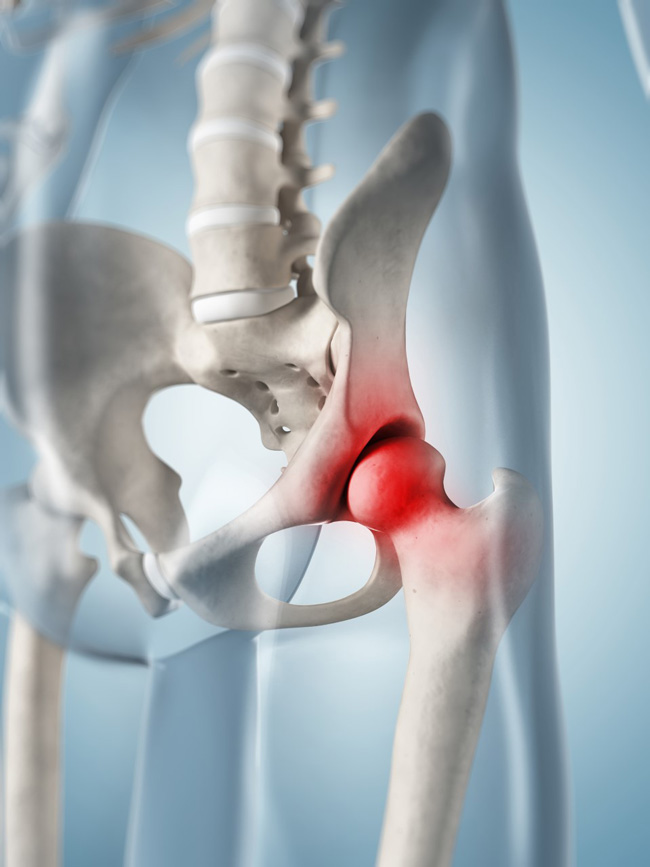 Researchers discover new genetic mutation linked to osteonecrosis of the hip
Researchers discover new genetic mutation linked to osteonecrosis of the hip
Scientists at the Research Institute of McGill University Health Centre (RI-MUHC) have discovered a new genetic mutation linked to osteonecrosis of the hip, specifically the femoral head – the spherical-shaped mass at the top of the femur. This breakthrough could allow doctors to identify and treat the disease before symptoms arise and potentially avoid hip replacements.
Osteonecrosis or “bone death” of the femoral head is a serious disease that is caused by interruption of blood flow in the hip bone. Patients experience pain as the disease progresses and the bone and surrounding joint collapse. Ultimately, in end-stage osteoarthritis, the patient becomes unable to walk and the hip joint must be replaced. “It is a severely debilitating disease that is usually linked to identifiable risk factors such as glucocorticoid treatments, blood cancers and in some rare cases, to a genetic cause,” explains Dr. Chantal Séguin, Hematologist-oncologist at the Bone Engineering and Vascular Biology Research Lab of the RI-MUHC, and senior author on the scientific paper published recently in the Journal of Medical Genetics.
Through the specialized Osteonecrosis Clinic established at the MUHC’s Montreal General Hospital, led by Dr. Séguin and orthopedic surgeon Dr. Ed Harvey, the researchers diagnosed advanced osteonecrosis in 4 out of 6 siblings in a family of European descent. Their team discovered a novel genetic mutation on a gene called TRPV4 (transient receptor potential vanilloid 4). The TRPV4 gene is known to play a critical role in blood flow control and bone cell development. Until this new discovery, only one other mutation had been identified in a few families of Asian descent and the findings have had limited potential for early diagnosis and new targeted therapy.

“The mutation was found to be common to all affected family members and absent in the unaffected family member, linking this new mutation to osteonecrosis,” says Dr. Séguin. “While it was known that pathogenic TRPV4 mutations affected the skeleton and the nervous system, this is the first time it has been associated with osteonecrosis of the femoral head.”
Although the true prevalence of the disease is unknown, as many as 30,000 new patients are diagnosed each year in the United States, and the incidence is increasing. Many patients are under the age of 25 when diagnosed. The lack of knowledge surrounding osteonecrosis places a major financial burden on the Quebec and Canadian healthcare system.
“If we consider all Europeans and their distribution worldwide, it is likely that this mutation could be found in larger populations,” explains Dr. Séguin. “The identification of this novel mutation will help to reveal the biological pathways that lead to the disease, and aid in the development of new treatments that target its cause rather than its symptoms.”
This novel discovery could also help to better understand the biological mechanisms in the much more common form of osteonecrosis of the femoral head, namely osteonecrosis induced by the use of glucocorticoids, or more commonly, steroids. Glucocorticoids are a family of medications used worldwide as either an anti-inflammatory agent, or as an important drug in many chemotherapy regimens used to treat patients with blood cancer. It is also well known that people who are using steroid medication for various illnesses are also at risk and it is estimated that greater than 60 million people are presently taking this medication worldwide.

Thank you and Bless You for all the hard work and researching Avascular Necrosis/ Osteonecrosis
I have avn in knee due to trauma
And run a support group
Please continue to study and research avn
Where do u get the blood test done to see if you have this TRPV 4 ? I already have AVN of both femurs! I got it from steroids for asthma!
Je suis un enseignant bilingue à l’école secondaire à Spruce Grove (Edmonton) qui cherche des traitements pour la nécrose avasculaire des hanches. Je suis prêt à participer à la recherche. 53 ans, diag en 2015–MRI
Ma diagnotique est idéopathique.
Téléphone: 780-720-2838.
I also would like to have the genetic test for my sons and for me. Comment je peux procéder? Si c’est nécessaire on pourrait venir a Montéal.
This is great news…i’m going for my ThR on 15 Nov…How i wish for a cure…everyday is hell with this AVN…but through the Grace of God i continue to believe in miracles… .